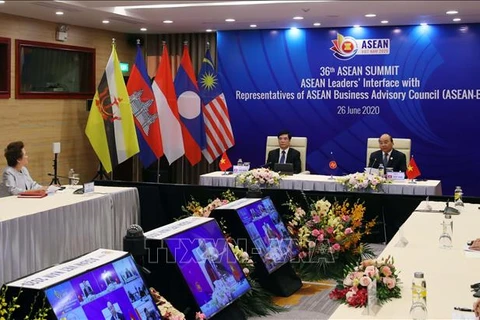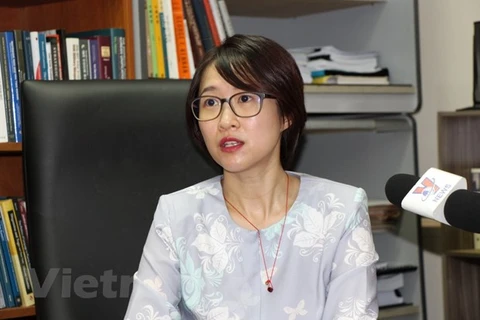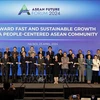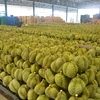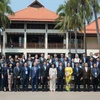Singapore (VNA) – In a recent interview granted to Vietnam News Agency correspondent in Singapore, Dr. Hoe Ee Khor, Chief Economist at the ASEAN+3 Macroeconomic Research Office (AMRO), expressed his impressions on Vietnam’s economic achievements and contributions to the Association of Southeast Asian Nations (ASEAN) since the country joined the bloc 25 years ago. Following is the interview:
Question: Vietnam has been an ASEAN member for 25 years (1995-2020). Could you tell us about the outstanding economic achievements of Vietnam in the 25 years of integration into ASEAN?
Answer: Since joining the ASEAN, Vietnam has embarked on a number of economic reforms and deepened economic ties with the rest of the world.
One of the key events was Vietnam’s accession to the WTO in 2007, which has resulted in a wave of foreign direct investment, which grew from about 3 billion USD in 1995 to 20 billion USD in 2019. Vietnam has successfully leveraged this influx of investment into export engines, particularly the electronics industry, which helped the country achieve one of the highest rates of economic growth in the region, averaging around 6.3 percent over the past 10 years. As a result, Vietnam’s per capita income has risen almost ten folds from around 277 USD in 1995 to 2,715 USD in 2019, and the economy is now one of ASEAN’s largest.
The country’s impressive economic achievements have benefited from the authorities’ efforts on deregulation and the lowering of the cost of doing business over the past few decades. At the same time, divestment of state-owned enterprises has led to greater efficiency and strengthened the domestic private sector’s participation in the economy, epitomised by large Vietnamese corporations such as Vingroup and Vietjet Air.
In addition to the economic development, the country has strengthened the social safety net through improvements in the pension and healthcare systems. A recent OECD pension survey of 47 countries shows that while Vietnam’s pension system coverage remains limited, the pension benefit is relatively high, at 75 percent of lifetime average. Between 2002 and 2018, more than 45 million people were lifted out of poverty, with the poverty rate declining from over 70 percent to below 6 percent amid the rapid rise of the middle class.
Question: What are Vietnam’ contributions to the overall economic development of the region over the past 25 years?
Answer: Over the past 25 years, the country has increasingly integrated itself into the global and regional economy. Vietnam’s manufacturing sector has become a crucial part of the regional value chain (RVC), in particular the electronics sector. Vietnam’s participation in the RVC increased from 26.4 percent in 2005 to 33.9 percent in 2015.
Moreover, for firms from other regional economies, Vietnam’s burgeoning middle class and rising income level have made the country a significant destination of final demand for goods and services.
Finally, Vietnam’s membership in the ASEAN Economic Community (AEC) and the proposed Regional Comprehensive Economic Partnership (RCEP) highlights Vietnam’s role in the regional community in supporting shared prosperity through the flow of goods and services. Vietnam’s economy complements the other economies. It was able to attract the labour intensive industries from China, Japan, and the Republic of Korea and ASEAN5 (Malaysia, Indonesia, the Philippines, Singapore, and Thailand) and leverage on that to plug into the regional production network. Since then, it has been moving up the value chain and grown into an industrial power with exports equivalent to around 100 percent of GDP. It has also been very successful in developing the agriculture sector and tourism.
Question: Vietnam has been an ASEAN member for 25 years (1995-2020). Could you tell us about the outstanding economic achievements of Vietnam in the 25 years of integration into ASEAN?
Answer: Since joining the ASEAN, Vietnam has embarked on a number of economic reforms and deepened economic ties with the rest of the world.
One of the key events was Vietnam’s accession to the WTO in 2007, which has resulted in a wave of foreign direct investment, which grew from about 3 billion USD in 1995 to 20 billion USD in 2019. Vietnam has successfully leveraged this influx of investment into export engines, particularly the electronics industry, which helped the country achieve one of the highest rates of economic growth in the region, averaging around 6.3 percent over the past 10 years. As a result, Vietnam’s per capita income has risen almost ten folds from around 277 USD in 1995 to 2,715 USD in 2019, and the economy is now one of ASEAN’s largest.
The country’s impressive economic achievements have benefited from the authorities’ efforts on deregulation and the lowering of the cost of doing business over the past few decades. At the same time, divestment of state-owned enterprises has led to greater efficiency and strengthened the domestic private sector’s participation in the economy, epitomised by large Vietnamese corporations such as Vingroup and Vietjet Air.
In addition to the economic development, the country has strengthened the social safety net through improvements in the pension and healthcare systems. A recent OECD pension survey of 47 countries shows that while Vietnam’s pension system coverage remains limited, the pension benefit is relatively high, at 75 percent of lifetime average. Between 2002 and 2018, more than 45 million people were lifted out of poverty, with the poverty rate declining from over 70 percent to below 6 percent amid the rapid rise of the middle class.
Question: What are Vietnam’ contributions to the overall economic development of the region over the past 25 years?
Answer: Over the past 25 years, the country has increasingly integrated itself into the global and regional economy. Vietnam’s manufacturing sector has become a crucial part of the regional value chain (RVC), in particular the electronics sector. Vietnam’s participation in the RVC increased from 26.4 percent in 2005 to 33.9 percent in 2015.
Moreover, for firms from other regional economies, Vietnam’s burgeoning middle class and rising income level have made the country a significant destination of final demand for goods and services.
Finally, Vietnam’s membership in the ASEAN Economic Community (AEC) and the proposed Regional Comprehensive Economic Partnership (RCEP) highlights Vietnam’s role in the regional community in supporting shared prosperity through the flow of goods and services. Vietnam’s economy complements the other economies. It was able to attract the labour intensive industries from China, Japan, and the Republic of Korea and ASEAN5 (Malaysia, Indonesia, the Philippines, Singapore, and Thailand) and leverage on that to plug into the regional production network. Since then, it has been moving up the value chain and grown into an industrial power with exports equivalent to around 100 percent of GDP. It has also been very successful in developing the agriculture sector and tourism.
<div class="flourish-embed flourish-bar-chart-race" data-src="visualisation/3262004" data-url="https://flo.uri.sh/visualisation/3262004/embed"><script src="https://public.flourish.studio/resources/embed.js"></script></div>
Question: In the first half of 2020, Southeast Asia in particular and the world in general experienced great turbulence as a result of COVID-19. What are the opportunities and challenges for the Vietnamese economy in the near future?
Answer: As far as near-term challenges are concerned, one of them is the extent to which the COVID-19 affects external demand. While domestic demand may soon pick up with Vietnam gradually easing movement restrictions, the recovery remains susceptible to the risk of a second wave of infections, to which the service sector is particularly vulnerable. However, external demand, especially for non-electrical and electronic sectors, will likely take longer to revive, a prospect that weighs heavily on the export sector.
In addition, supply chain disruptions pose an obstacle to a supply side recovery. Meanwhile, uncertainty in the phase in the global technology cycle constitutes another risk factor.
That said, Vietnam’s expanding number of free trade agreements, including the recently signed EU-Vietnam FTA, should help sustain exports as the economy’s main growth engine.
Other important risks to monitor include uncertainty in global financial markets, which could lead to increased volatility in capital flows, although Vietnam may be less vulnerable than other regional economies due to its limited exposure to non-residents’ portfolio investment compared to foreign direct investment.
Lastly, one of the main vulnerabilities for the financial sector is the impact of the pandemic on banks’ asset quality. Despite the banks’ efforts on loan restructuring and reduction in interest and fees, it remains likely that the banking system’s asset quality will deteriorate and erode its relatively low capital buffers.
Vietnam’s economy faces a number of opportunities to enhance its growth prospect. Vietnam’s competitive labour, easy access to key regional and global markets through FTAs, and the government’s favourable treatment of foreign companies on various aspects ranging from tax incentives to land-use rights make it highly attractive for investment. Amid supply-chain repercussions from global trade tensions and the pandemic, multinational corporations are relocating and co-locating their production facilities to Vietnam.
Furthermore, the country’s growing number of FTAs, most recently the EU-Vietnam FTA, can help Vietnam diversify its exposure to fluctuations in external demand.
Lastly, Vietnam’s relatively successful management of the COVID-19 pandemic can provide a backdrop against which to increase spending on infrastructure and attract foreign investment to obtain a head start in recovery as the global economy emerges into the post-pandemic environment./.
Question: In the first half of 2020, Southeast Asia in particular and the world in general experienced great turbulence as a result of COVID-19. What are the opportunities and challenges for the Vietnamese economy in the near future?
Answer: As far as near-term challenges are concerned, one of them is the extent to which the COVID-19 affects external demand. While domestic demand may soon pick up with Vietnam gradually easing movement restrictions, the recovery remains susceptible to the risk of a second wave of infections, to which the service sector is particularly vulnerable. However, external demand, especially for non-electrical and electronic sectors, will likely take longer to revive, a prospect that weighs heavily on the export sector.
In addition, supply chain disruptions pose an obstacle to a supply side recovery. Meanwhile, uncertainty in the phase in the global technology cycle constitutes another risk factor.
That said, Vietnam’s expanding number of free trade agreements, including the recently signed EU-Vietnam FTA, should help sustain exports as the economy’s main growth engine.
Other important risks to monitor include uncertainty in global financial markets, which could lead to increased volatility in capital flows, although Vietnam may be less vulnerable than other regional economies due to its limited exposure to non-residents’ portfolio investment compared to foreign direct investment.
Lastly, one of the main vulnerabilities for the financial sector is the impact of the pandemic on banks’ asset quality. Despite the banks’ efforts on loan restructuring and reduction in interest and fees, it remains likely that the banking system’s asset quality will deteriorate and erode its relatively low capital buffers.
Vietnam’s economy faces a number of opportunities to enhance its growth prospect. Vietnam’s competitive labour, easy access to key regional and global markets through FTAs, and the government’s favourable treatment of foreign companies on various aspects ranging from tax incentives to land-use rights make it highly attractive for investment. Amid supply-chain repercussions from global trade tensions and the pandemic, multinational corporations are relocating and co-locating their production facilities to Vietnam.
Furthermore, the country’s growing number of FTAs, most recently the EU-Vietnam FTA, can help Vietnam diversify its exposure to fluctuations in external demand.
Lastly, Vietnam’s relatively successful management of the COVID-19 pandemic can provide a backdrop against which to increase spending on infrastructure and attract foreign investment to obtain a head start in recovery as the global economy emerges into the post-pandemic environment./.
VNA



